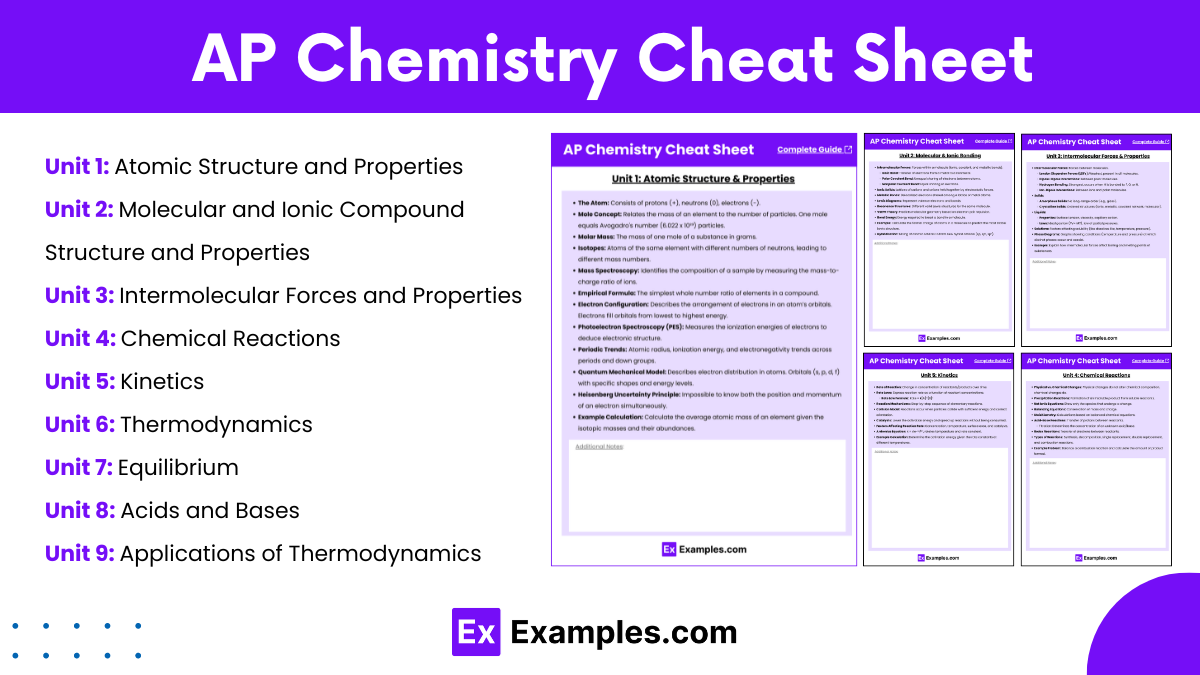This comprehensive AP Chemistry Cheatsheet provides essential formulas, key concepts, and critical information across all units of the AP Chemistry curriculum. By summarizing complex topics into easy-to-understand points, it helps students efficiently review and reinforce their knowledge. The inclusion of specific formulas and example problems aids in the application of theoretical concepts, ensuring students are well-prepared for both multiple-choice and free-response questions on the exam. With clear, concise explanations and organized sections, this cheatsheet is an invaluable study aid for achieving a high score on the AP Chemistry exam.
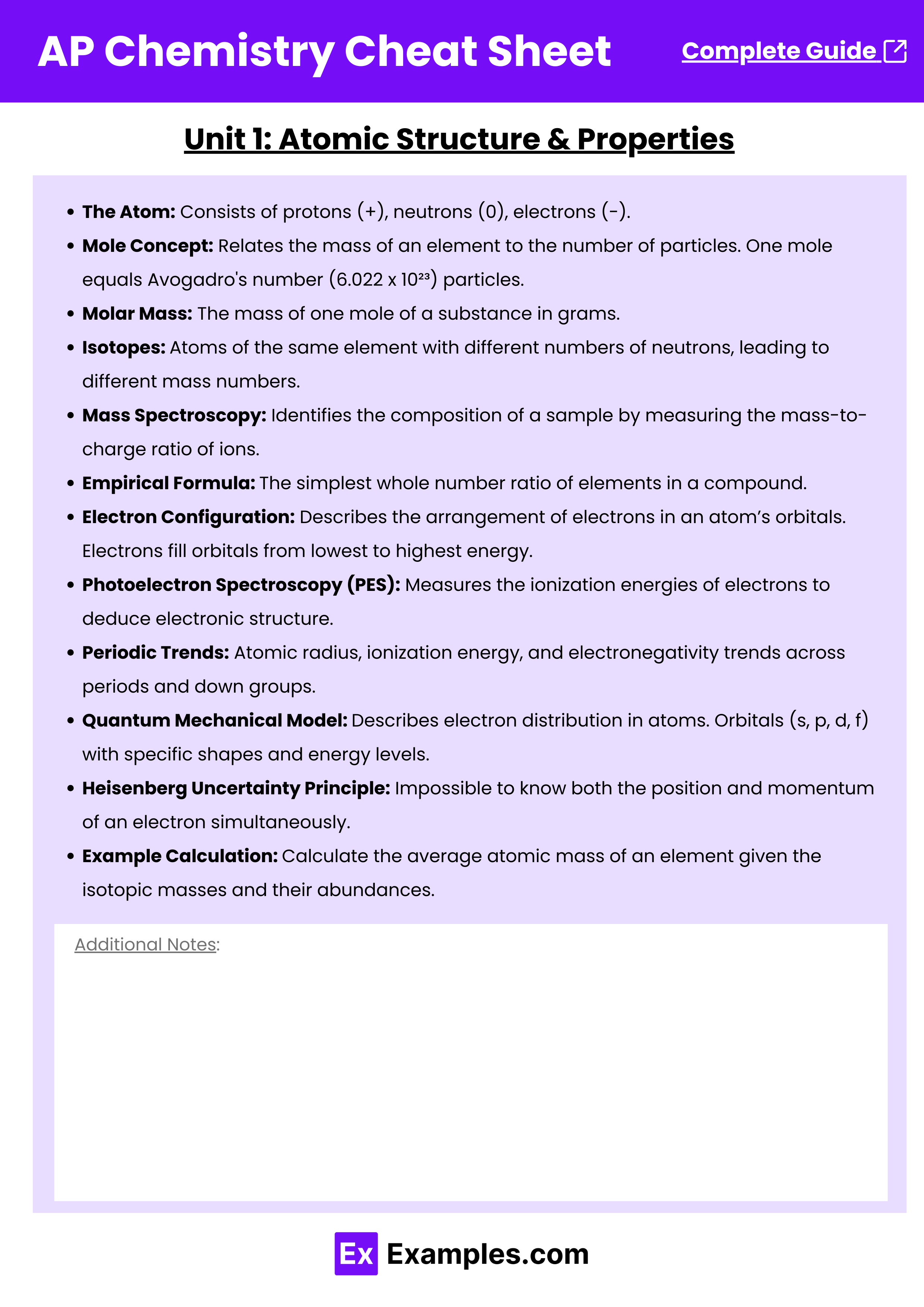
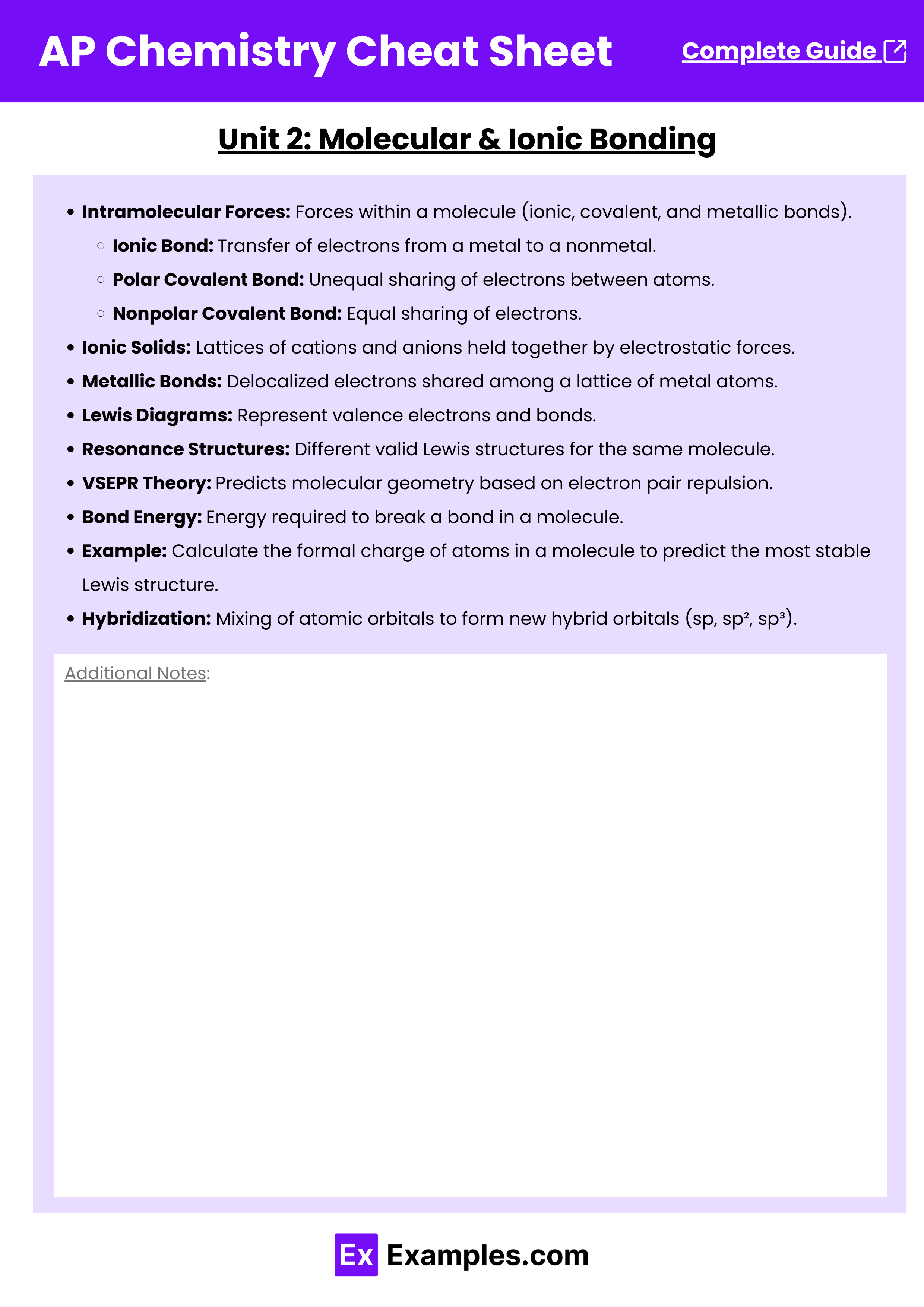
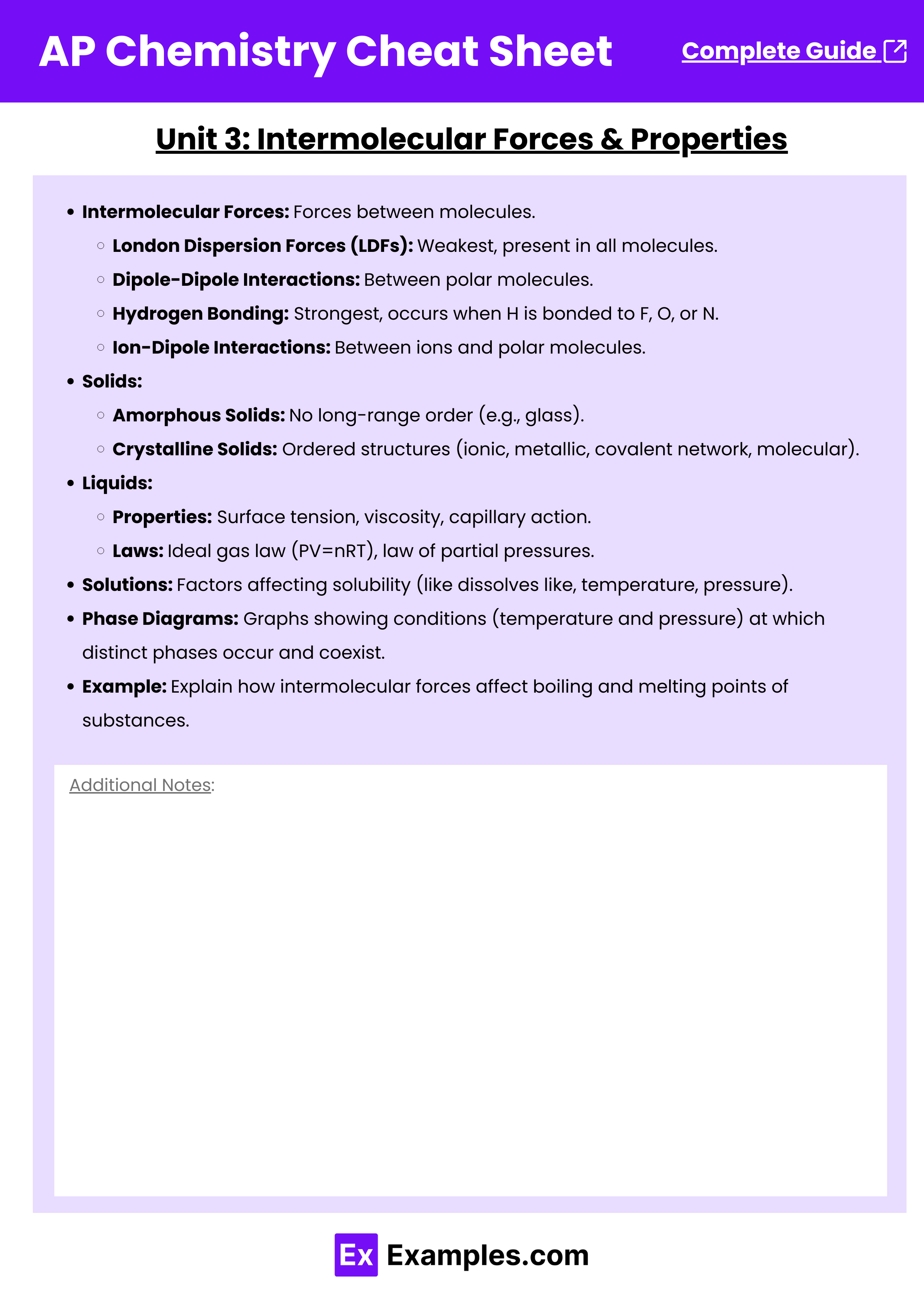
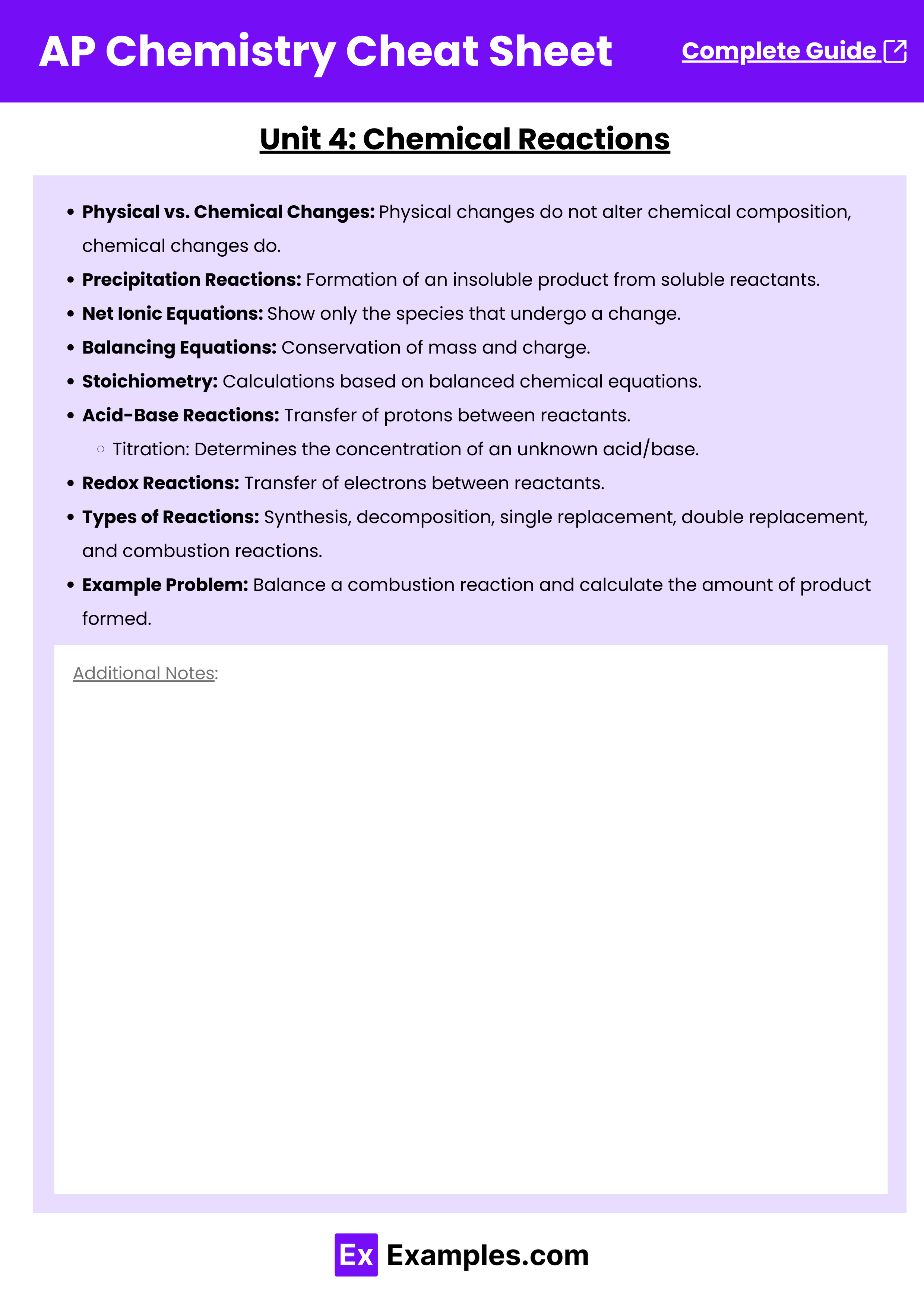

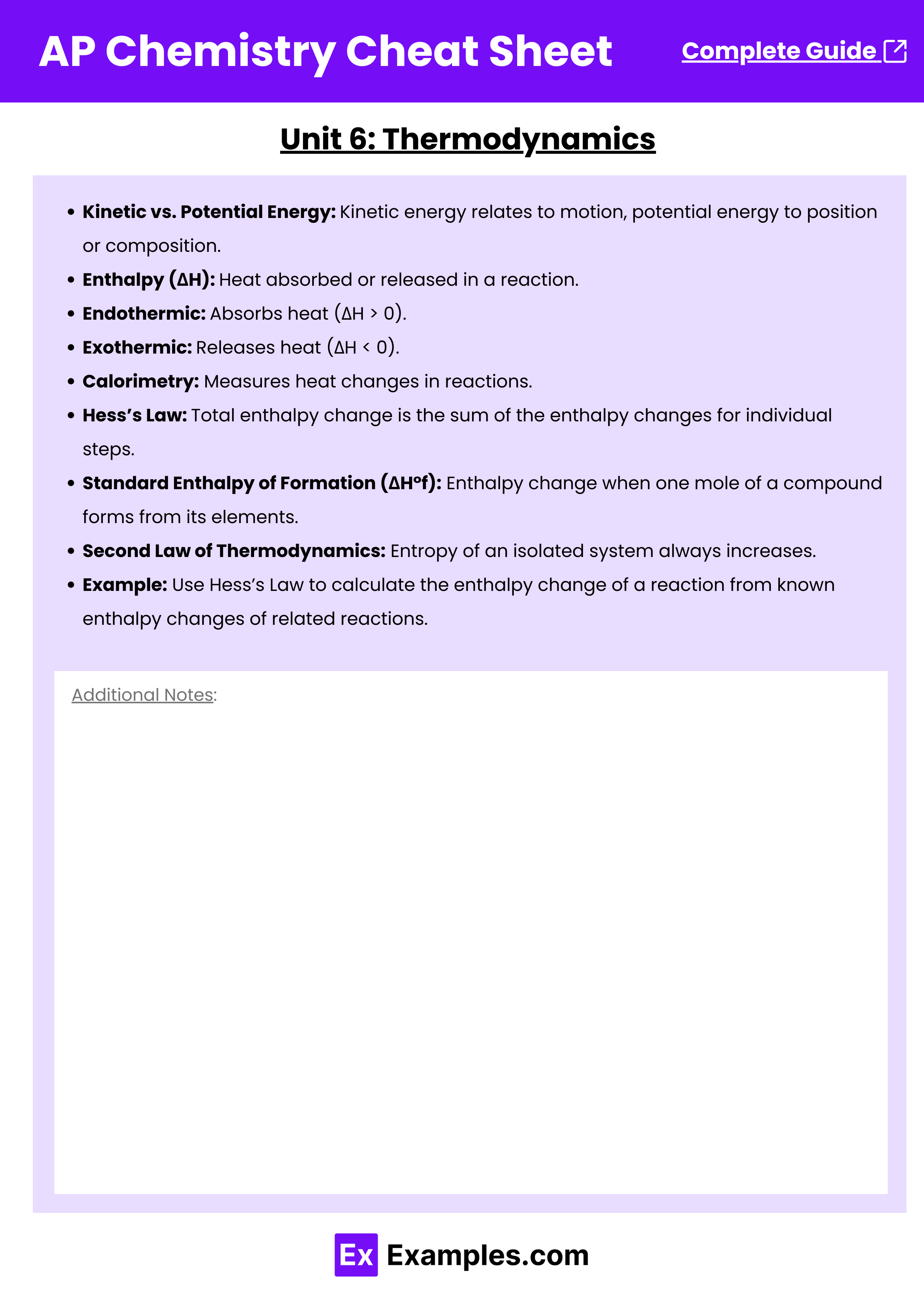
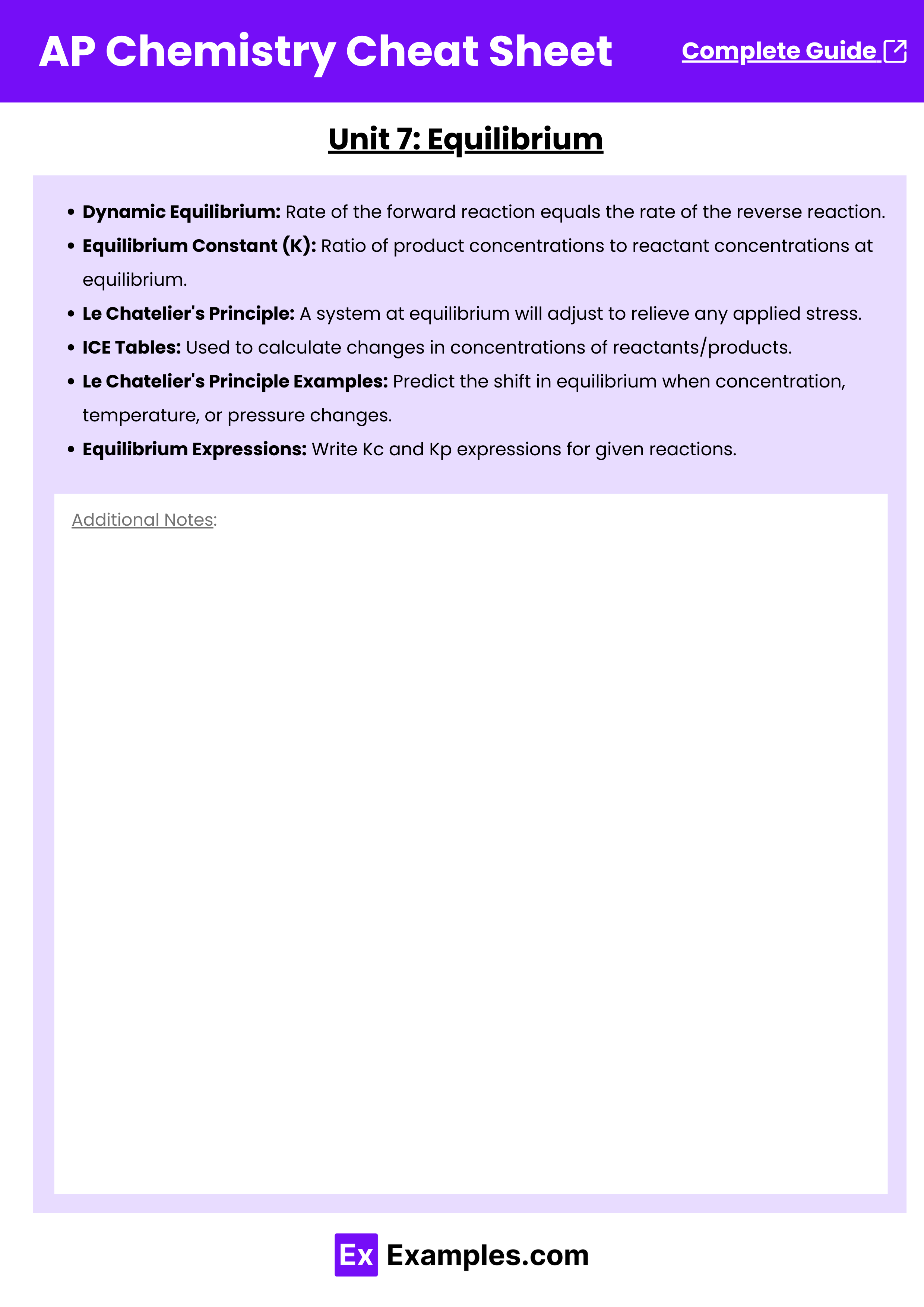
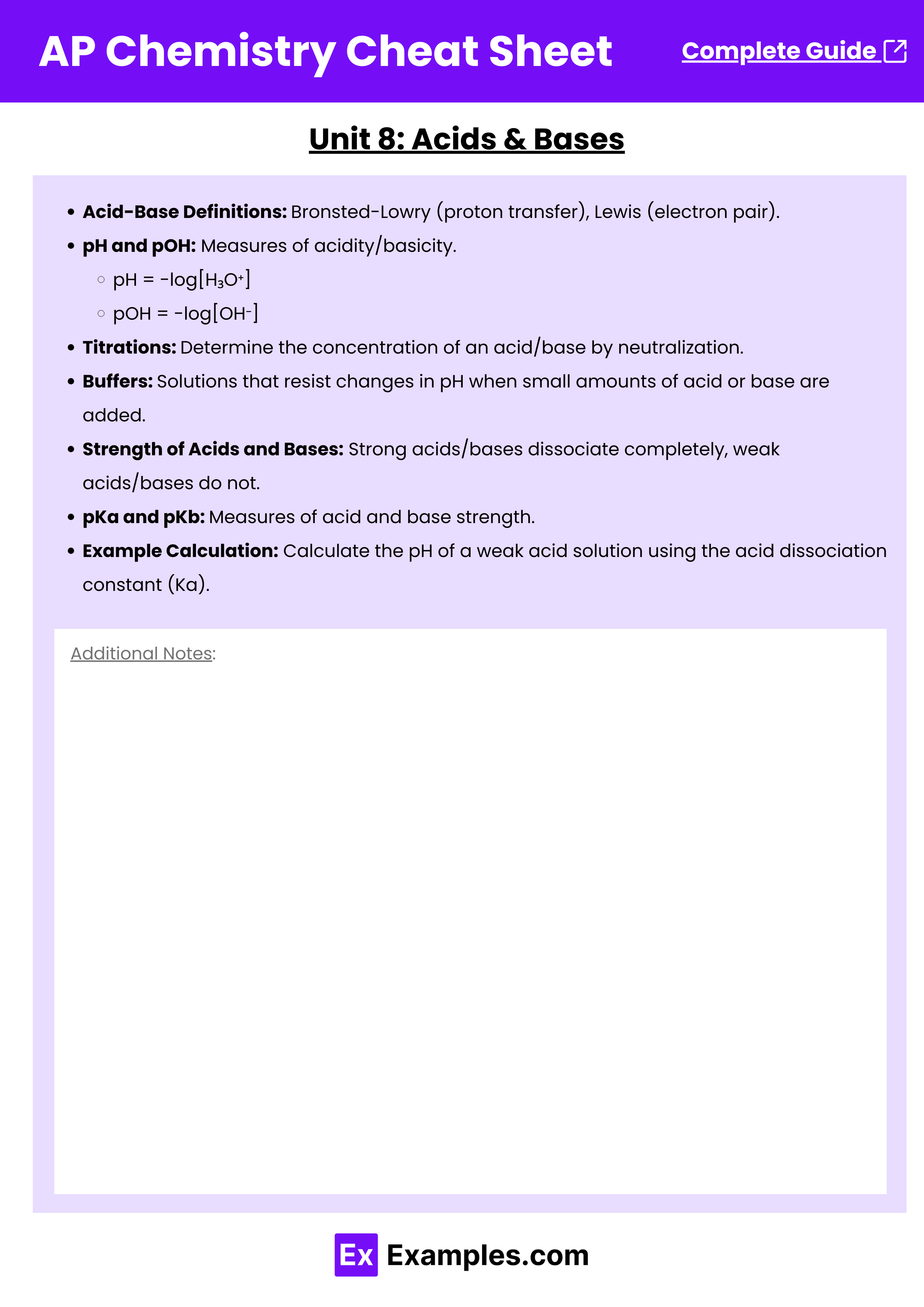
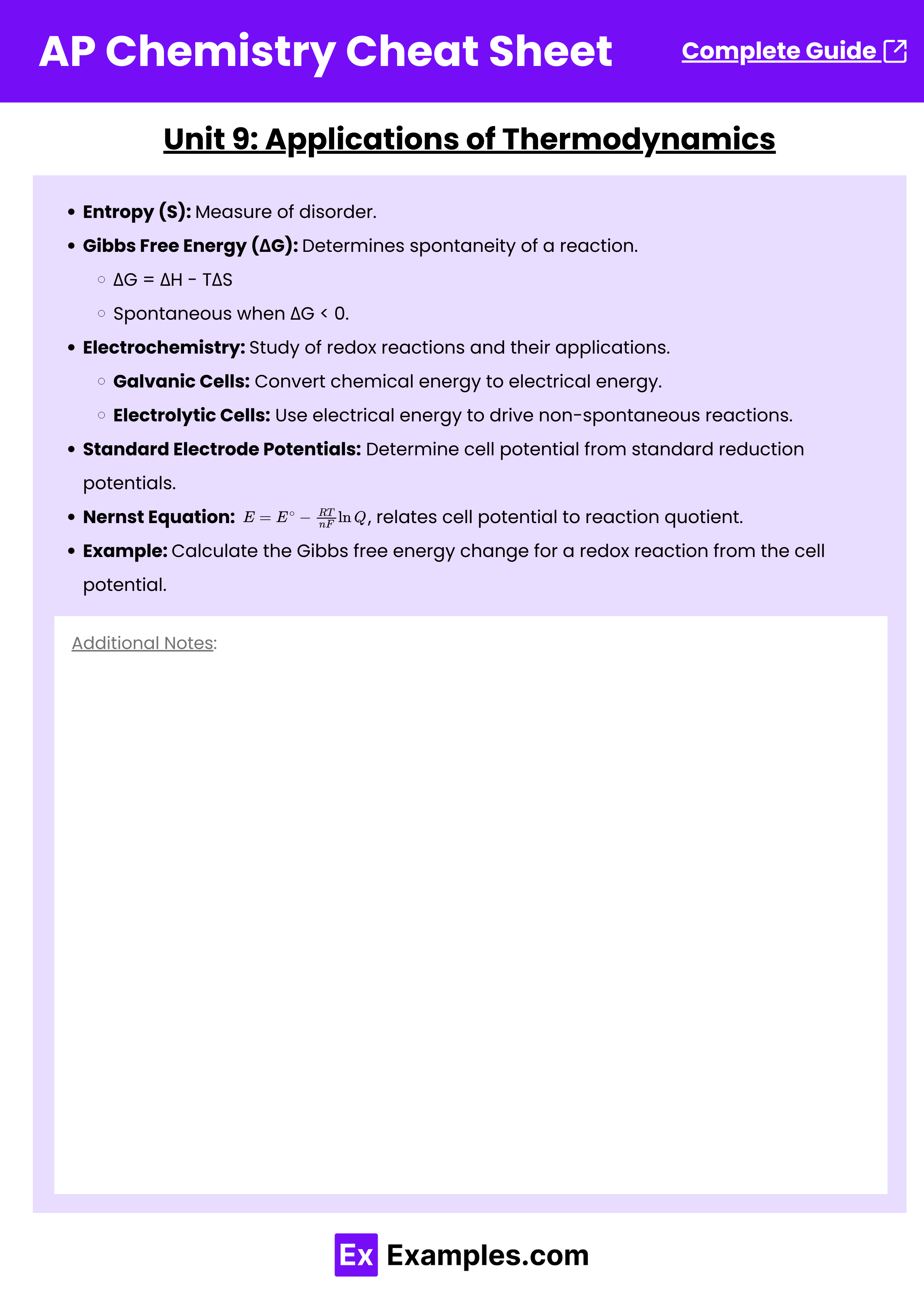
Unit 1: Atomic Structure & Properties
- The Atom: Consists of protons (+), neutrons (0), electrons (-).
- Mole Concept: Relates the mass of an element to the number of particles. One mole equals Avogadro’s number (6.022 x 10²³) particles.
- Molar Mass: The mass of one mole of a substance in grams.
- Isotopes: Atoms of the same element with different numbers of neutrons, leading to different mass numbers.
- Mass Spectroscopy: Identifies the composition of a sample by measuring the mass-to-charge ratio of ions.
- Empirical Formula: The simplest whole number ratio of elements in a compound.
- Electron Configuration: Describes the arrangement of electrons in an atom’s orbitals. Electrons fill orbitals from lowest to highest energy.
- Photoelectron Spectroscopy (PES): Measures the ionization energies of electrons to deduce electronic structure.
- Periodic Trends: Atomic radius, ionization energy, and electronegativity trends across periods and down groups.
- Quantum Mechanical Model: Describes electron distribution in atoms. Orbitals (s, p, d, f) with specific shapes and energy levels.
- Heisenberg Uncertainty Principle: Impossible to know both the position and momentum of an electron simultaneously.
- Example Calculation: Calculate the average atomic mass of an element given the isotopic masses and their abundances.
Unit 2: Molecular & Ionic Bonding
- Intramolecular Forces: Forces within a molecule (ionic, covalent, and metallic bonds).
- Ionic Bond: Transfer of electrons from a metal to a nonmetal.
- Polar Covalent Bond: Unequal sharing of electrons between atoms.
- Nonpolar Covalent Bond: Equal sharing of electrons.
- Ionic Solids: Lattices of cations and anions held together by electrostatic forces.
- Metallic Bonds: Delocalized electrons shared among a lattice of metal atoms.
- Lewis Diagrams: Represent valence electrons and bonds.
- Resonance Structures: Different valid Lewis structures for the same molecule.
- VSEPR Theory: Predicts molecular geometry based on electron pair repulsion.
- Bond Energy: Energy required to break a bond in a molecule.
- Example: Calculate the formal charge of atoms in a molecule to predict the most stable Lewis structure.
- Hybridization: Mixing of atomic orbitals to form new hybrid orbitals (sp, sp², sp³).
Unit 3: Intermolecular Forces & Properties
- Intermolecular Forces: Forces between molecules.
- London Dispersion Forces (LDFs): Weakest, present in all molecules.
- Dipole-Dipole Interactions: Between polar molecules.
- Hydrogen Bonding: Strongest, occurs when H is bonded to F, O, or N.
- Ion-Dipole Interactions: Between ions and polar molecules.
- Solids:
- Amorphous Solids: No long-range order (e.g., glass).
- Crystalline Solids: Ordered structures (ionic, metallic, covalent network, molecular).
- Liquids:
- Properties: Surface tension, viscosity, capillary action.
- Laws: Ideal gas law (PV=nRT), law of partial pressures.
- Solutions: Factors affecting solubility (like dissolves like, temperature, pressure).
- Phase Diagrams: Graphs showing conditions (temperature and pressure) at which distinct phases occur and coexist.
- Example: Explain how intermolecular forces affect boiling and melting points of substances.
Unit 4: Chemical Reactions
- Physical vs. Chemical Changes: Physical changes do not alter chemical composition, chemical changes do.
- Precipitation Reactions: Formation of an insoluble product from soluble reactants.
- Net Ionic Equations: Show only the species that undergo a change.
- Balancing Equations: Conservation of mass and charge.
- Stoichiometry: Calculations based on balanced chemical equations.
- Acid-Base Reactions: Transfer of protons between reactants.
- Titration: Determines the concentration of an unknown acid/base.
- Redox Reactions: Transfer of electrons between reactants.
- Types of Reactions: Synthesis, decomposition, single replacement, double replacement, and combustion reactions.
- Example Problem: Balance a combustion reaction and calculate the amount of product formed.
Unit 5: Kinetics
- Rate of Reaction: Change in concentration of reactants/products over time.
- Rate Laws: Express reaction rate as a function of reactant concentrations.
- Rate Law Formula: Rate=𝑘[𝐴]𝑚[𝐵]𝑛Rate=k[A]m[B]n
- Reaction Mechanisms: Step-by-step sequence of elementary reactions.
- Collision Model: Reactions occur when particles collide with sufficient energy and correct orientation.
- Catalysts: Lower the activation energy and speed up reactions without being consumed.
- Factors Affecting Reaction Rate: Concentration, temperature, surface area, and catalysts.
- Arrhenius Equation: 𝑘=𝐴𝑒−𝐸𝑎/𝑅𝑇k=Ae−Ea/RT, relates temperature and rate constant.
- Example Calculation: Determine the activation energy given the rate constants at different temperatures.
Unit 6: Thermodynamics
- Kinetic vs. Potential Energy: Kinetic energy relates to motion, potential energy to position or composition.
- Enthalpy (ΔH): Heat absorbed or released in a reaction.
- Endothermic: Absorbs heat (ΔH > 0).
- Exothermic: Releases heat (ΔH < 0).
- Calorimetry: Measures heat changes in reactions.
- Hess’s Law: Total enthalpy change is the sum of the enthalpy changes for individual steps.
- Standard Enthalpy of Formation (ΔH°f): Enthalpy change when one mole of a compound forms from its elements.
- Second Law of Thermodynamics: Entropy of an isolated system always increases.
- Example: Use Hess’s Law to calculate the enthalpy change of a reaction from known enthalpy changes of related reactions.
Unit 7: Equilibrium
- Dynamic Equilibrium: Rate of the forward reaction equals the rate of the reverse reaction.
- Equilibrium Constant (K): Ratio of product concentrations to reactant concentrations at equilibrium.
- Le Chatelier’s Principle: A system at equilibrium will adjust to relieve any applied stress.
- ICE Tables: Used to calculate changes in concentrations of reactants/products.
- Le Chatelier’s Principle Examples: Predict the shift in equilibrium when concentration, temperature, or pressure changes.
- Equilibrium Expressions: Write Kc and Kp expressions for given reactions.
Unit 8: Acids & Bases
- Acid-Base Definitions: Bronsted-Lowry (proton transfer), Lewis (electron pair).
- pH and pOH: Measures of acidity/basicity.
- pH = -log[H₃O⁺]
- pOH = -log[OH⁻]
- Titrations: Determine the concentration of an acid/base by neutralization.
- Buffers: Solutions that resist changes in pH when small amounts of acid or base are added.
- Strength of Acids and Bases: Strong acids/bases dissociate completely, weak acids/bases do not.
- pKa and pKb: Measures of acid and base strength.
- Example Calculation: Calculate the pH of a weak acid solution using the acid dissociation constant (Ka).
Unit 9: Applications of Thermodynamics
- Entropy (S): Measure of disorder.
- Gibbs Free Energy (ΔG): Determines spontaneity of a reaction.
- ΔG = ΔH – TΔS
- Spontaneous when ΔG < 0.
- Electrochemistry: Study of redox reactions and their applications.
- Galvanic Cells: Convert chemical energy to electrical energy.
- Electrolytic Cells: Use electrical energy to drive non-spontaneous reactions.
- Standard Electrode Potentials: Determine cell potential from standard reduction potentials.
These additions provide more depth and context, making the cheat sheet even more helpful for students preparing for the AP Chemistry exam.

